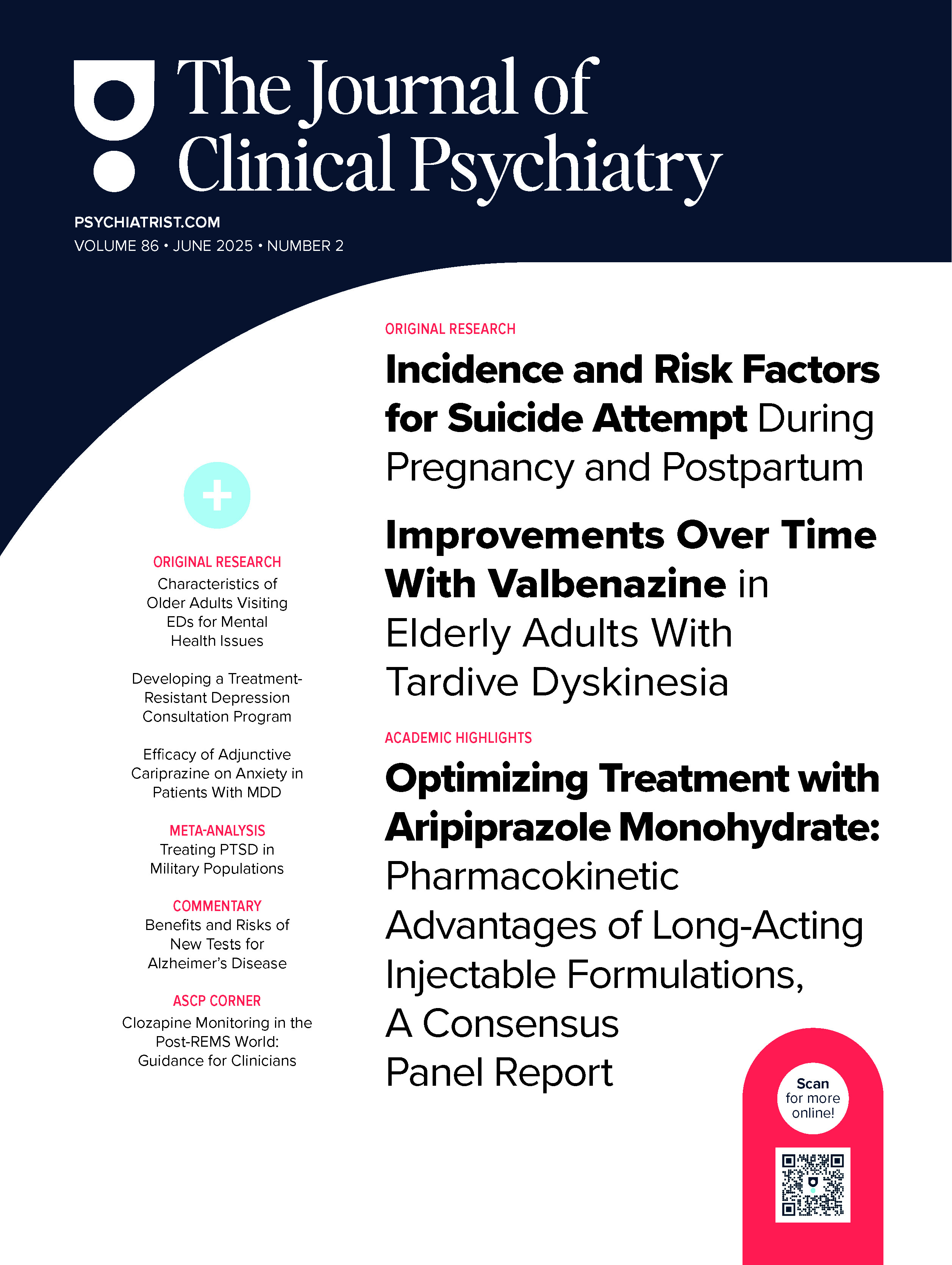ABSTRACT
Objective: Little is known about the amyloid load impact on depressive symptoms or disorders, although it can modulate the cognitive trajectory in older adults. Here, we analyzed, in individuals at risk of Alzheimer’s dementia, the relationship between amyloid load and depressive symptoms changes over time.
Methods: This study included ≥ 70-year-old participants from the French Multidomain Alzheimer Preventive Trial (MAPT) (May 2008 to February 2011) who underwent brain amyloid load measurement by β-amyloid-[18F] florbetapir-PET at baseline and had spontaneous memory complaints and/or limitation in 1 instrumental activity of daily living or slow walking gait (N = 264). Symptoms of depression were measured with the Geriatric Depression Scale–15 items (GDS) at baseline and 6, 12, 24, and 36 months of follow-up. Four GDS factors were determined by principal component analysis (PCA): life satisfaction, level of apathy, self-esteem, and anxiety. Amyloid positive status was defined based on the amyloid load in 6 Alzheimer’s dementia–related regions. Regional amyloid load was based on 3 dimensions defined by PCA. The longitudinal links between depressive symptomatology and amyloid load (ie, cortical AV45 and amyloid load dimensions) were analyzed using linear mixed-multivariate models.
Results: At baseline, 11% of participants had depressive symptoms (GDS > 5) and 34% were amyloid-positive. The global amyloid load was not associated with worsening of the total GDS score but only with the impairment of self-esteem factor during the follow-up after adjustment for age, sex, education level, and drug intake, dementia, and Mini-Mental State Examination score (β = −0.029, 95% CI [−0.052 to −0.007], P = .003). Regional amyloid load in hippocampus and bilateral caudate nucleus protected significantly from self-esteem decrease during the 3-year follow-up.
Conclusions: Although amyloid load shows no impact on GDS score in subjects at risk of Alzheimer’s dementia, amyloid load may influence the progression of depressive dimension (self-esteem) with different effects according to the regional burden.
Trial Registration: ClinicalTrials.gov identifier: NCT00672685
Members Only Content
This full article is available exclusively to Professional tier members. Subscribe now to unlock the HTML version and gain unlimited access to our entire library plus all PDFs. If you’re already a subscriber, please log in below to continue reading.
References (44)

- Lyketsos CG, Olin J. Depression in Alzheimer’s disease: overview and treatment. Biol Psychiatry. 2002;52(3):243–252. PubMed CrossRef
- Richard E, Reitz C, Honig LH, et al. Late-life depression, mild cognitive impairment, and dementia. JAMA Neurol. 2013;70(3):374–382. PubMed CrossRef
- Hargrave R, Reed B, Mungas D. Depressive syndromes and functional disability in dementia. J Geriatr Psychiatry Neurol. 2000;13(2):72–77. PubMed CrossRef
- Conejero I, Navucet S, Keller J, et al. A complex relationship between suicide, dementia, and amyloid: a narrative review. Front Neurosci. 2018;12:371. PubMed CrossRef
- Murphy MP, LeVine H 3rd. Alzheimer’s disease and the amyloid-β J Alzheimers Dis. 2010;19(1):311–323. PubMed CrossRef
- Querol-Vilaseca M, Colom-Cadena M, Pegueroles J, et al. Nanoscale structure of amyloid-β plaques in Alzheimer’s disease. Sci Rep. 2019;9(1):5181. PubMed CrossRef
- Marano C, Workman C, Lyman C, et al. Cortical beta-amyloid deposition in late-life depression. Am J Geriatr Psychiatry. 2013;21(3):S127. CrossRef
- Wu K-Y, Hsiao I-T, Chen C-S, et al. Increased brain amyloid deposition in patients with a lifetime history of major depression: evidenced on 18F-florbetapir (AV-45/Amyvid) positron emission tomography. Eur J Nucl Med Mol Imaging. 2014;41(4):714–722. PubMed CrossRef
- Chung JK, Plitman E, Nakajima S, et al; Alzheimer’s Disease Neuroimaging Initiative. lifetime history of depression predicts increased amyloid-β accumulation in patients with mild cognitive impairment. J Alzheimers Dis. 2015;45(3):907–919. PubMed CrossRef
- Tateno A, Sakayori T, Higuchi M, et al. Amyloid imaging with [(18)F]florbetapir in geriatric depression: early-onset versus late-onset. Int J Geriatr Psychiatry. 2015;30(7):720–728. PubMed CrossRef
- Li P, Hsiao I-T, Liu C-Y, et al. Beta-amyloid deposition in patients with major depressive disorder with differing levels of treatment resistance: a pilot study. EJNMMI Res. 2017;7(1):24. PubMed CrossRef
- Wu K-Y, Lin K-J, Chen C-H, et al. Diversity of neurodegenerative pathophysiology in nondemented patients with major depressive disorder: evidence of cerebral amyloidosis and hippocampal atrophy. Brain Behav. 2018;8(7):e01016. PubMed CrossRef
- Lavretsky H, Siddarth P, Kepe V, et al. Depression and anxiety symptoms are associated with cerebral FDDNP-PET binding in middle-aged and older nondemented adults. Am J Geriatr Psychiatry. 2009;17(6):493–502. PubMed CrossRef
- Kumar A, Kepe V, Barrio JR, et al. Protein binding in patients with late-life depression. Arch Gen Psychiatry. 2011;68(11):1143–1150. PubMed CrossRef
- Madsen K, Hasselbalch BJ, Frederiksen KS, et al. Lack of association between prior depressive episodes and cerebral [11C]PiB binding. Neurobiol Aging. 2012;33(10):2334–2342. PubMed CrossRef
- Yasuno F, Kazui H, Morita N, et al. High amyloid-β deposition related to depressive symptoms in older individuals with normal cognition: a pilot study. Int J Geriatr Psychiatry. 2016;31(8):920–928. PubMed CrossRef
- Donovan NJ, Locascio JJ, Marshall GA, et al; Harvard Aging Brain Study. Longitudinal association of amyloid beta and anxious-depressive symptoms in cognitively normal older adults. Am J Psychiatry. 2018;175(6):530–537. PubMed CrossRef
- Harrington KD, Lim YY, Gould E, et al. Amyloid-beta and depression in healthy older adults: a systematic review. Aust N Z J Psychiatry. 2015;49(1):36–46. PubMed CrossRef
- Vellas B, Carrie I, Gillette-Guyonnet S, et al. MAPT study: a multidomain approach for preventing Alzheimer’s disease: design and baseline data. J Prev Alzheimers Dis. 2014;1(1):13–22. PubMed
- Andrieu S, Guyonnet S, Coley N, et al; MAPT Study Group. Effect of long-term omega 3 polyunsaturated fatty acid supplementation with or without multidomain intervention on cognitive function in elderly adults with memory complaints (MAPT): a randomised, placebo-controlled trial. Lancet Neurol. 2017;16(5):377–389. PubMed CrossRef
- Vinkers DJ, Gussekloo J, Stek ML, et al. The 15-item Geriatric Depression Scale (GDS-15) detects changes in depressive symptoms after a major negative life event: the Leiden 85-plus Study. Int J Geriatr Psychiatry. 2004;19(1):80–84. PubMed CrossRef
- Katz S, Ford AB, Moskowitz RW, et al. The index of ADL: a standardized measure of biological and psychosocial function. JAMA. 1963;185(12):914–919. PubMed CrossRef
- Yesavage JA, Brink TL, Rose TL, et al. Development and validation of a geriatric depression screening scale: a preliminary report. J Psychiatr Res. 1982-1983;17(1):37–49. PubMed CrossRef
- Marc LG, Raue PJ, Bruce ML. Screening performance of the 15-item Geriatric Depression Scale in a diverse elderly home care population. Am J Geriatr Psychiatry. 2008;16(11):914–921. PubMed CrossRef
- Wancata J, Alexandrowicz R, Marquart B, et al. The criterion validity of the Geriatric Depression Scale: a systematic review. Acta Psychiatr Scand. 2006;114(6):398–410. PubMed CrossRef
- Bleecker ML, Bolla-Wilson K, Kawas C, et al. Age-specific norms for the Mini-Mental State Exam. Neurology. 1988;38(10):1565–1568. PubMed CrossRef
- Hughes CP, Berg L, Danziger WL, et al. A new clinical scale for the staging of dementia. Br J Psychiatry. 1982;140(6):566–572. PubMed CrossRef
- Friedman B, Heisel MJ, Delavan RL. Psychometric properties of the 15-item Geriatric Depression Scale in functionally impaired, cognitively intact, community-dwelling elderly primary care patients. J Am Geriatr Soc. 2005;53(9):1570–1576. PubMed CrossRef
- Pruessner JC, Baldwin MW, Dedovic K, et al. Self-esteem, locus of control, hippocampal volume, and cortisol regulation in young and old adulthood. Neuroimage. 2005;28(4):815–826. PubMed CrossRef
- Orth U, Robins RW, Widaman KF. Life-span development of self-esteem and its effects on important life outcomes. J Pers Soc Psychol. 2012;102(6):1271–1288. PubMed CrossRef
- Orth U, Robins RW, Trzesniewski KH, et al. Low self-esteem is a risk factor for depressive symptoms from young adulthood to old age. J Abnorm Psychol. 2009;118(3):472–478. PubMed CrossRef
- Sowislo JF, Orth U. Does low self-esteem predict depression and anxiety? a meta-analysis of longitudinal studies. Psychol Bull. 2013;139(1):213–240. PubMed CrossRef
- Bothwell R, Scott J. The influence of cognitive variables on recovery in depressed inpatients. J Affect Disord. 1997;43(3):207–212. PubMed CrossRef
- Liu SY, Wrosch C, Miller GE, et al. Self-esteem change and diurnal cortisol secretion in older adulthood. Psychoneuroendocrinology. 2014;41:111–120. PubMed CrossRef
- Eberl C, Winkler I, Pawelczack S, et al. Self-esteem consistency predicts the course of therapy in depressed patients. PLoS One. 2018;13(7):e0199957. PubMed CrossRef
- Wagner J, Gerstorf D, Hoppmann C, et al. The nature and correlates of self-esteem trajectories in late life. J Pers Soc Psychol. 2013;105(1):139–153. PubMed CrossRef
- Wagner J, Hoppmann C, Ram N, et al. Self-esteem is relatively stable late in life: the role of resources in the health, self-regulation, and social domains. Dev Psychol. 2015;51(1):136–149. PubMed CrossRef
- Mori T, Shimada H, Shinotoh H, et al. Apathy correlates with prefrontal amyloid β deposition in Alzheimer’s disease. J Neurol Neurosurg Psychiatry. 2014;85(4):449–455. PubMed CrossRef
- Marshall GA, Donovan NJ, Lorius N, et al. Apathy is associated with increased amyloid burden in mild cognitive impairment. J Neuropsychiatry Clin Neurosci. 2013;25(4):302–307. PubMed CrossRef
- Cummings JL. The Neuropsychiatric Inventory: assessing psychopathology in dementia patients. Neurology. 1997;48(suppl 6):S10–S16. PubMed CrossRef
- Incalzi RA, Cesari M, Pedone C, et al. Construct validity of the 15-item Geriatric Depression Scale in older medical inpatients. J Geriatr Psychiatry Neurol. 2003;16(1):23–28. PubMed CrossRef
- Copeland JR, Beekman AT, Braam AW, et al. Depression among older people in Europe: the EURODEP studies. World Psychiatry. 2004;3(1):45–49. PubMed
- de Sousa RD, Rodrigues AM, Gregório MJ, et al. Anxiety and depression in the Portuguese older adults: prevalence and associated factors. Front Med (Lausanne). 2017;4:196. PubMed CrossRef
- Thompson LI, Jones RN. Depression screening in cognitively normal older adults: measurement bias according to subjective memory decline, brain amyloid burden, cognitive function, and sex. Alzheimers Dement (Amst). 2020;12(1):e12107. PubMed CrossRef





